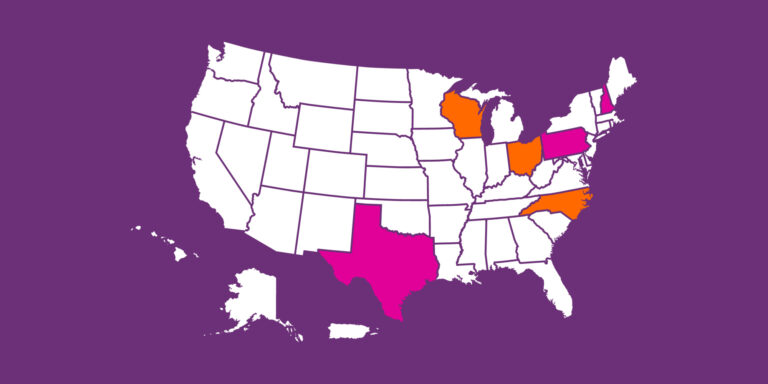What You Need to Know: Arkansas’s Proposed ESA Program
Arkansas lawmakers are proposing to transform education in the state through the introduction of an education savings account (ESA) program. The Learns Act, proposed via SB 294 this month, would create an ESA program—the Children’s Educational Freedom Account Program—which would be available to all K–12 students in Arkansas by 2025.
If enacted, families will be able to use this program to pay for educational expenses, including private school tuition and approved educational goods and services. The proposed program would be funded through the state’s foundation funding formula, offering students 90 percent of the prior year’s statewide per-pupil average.
Learn more below, including eligibility, funding regulations, FAQs and more.
Note: The information provided on this page is based on the initial program proposal and may not reflect amendments incorporated throughout the legislative process. The content of this page will be updated to reflect major amendments, and in the event legislation is enacted. (Last updated February 22, 2023.)
Program Fast Facts
- 3rd – Would create Arkansas’ third school choice program
- 100% – Student Eligibility To Be Universal by 2025
- 90% – Account Value as a Percentage of Public School Per-student Spending
Student Funding
As proposed, the Arkansas ESAs are equal to 90 percent of what the state spent per student in the prior education year ($7,349 in 2022-23). Initial ESAs would be valued at $6,600.
Qualifying expenses for Education Savings Accounts include private school tuition and fees; testing; uniforms; tutoring; curriculum; supplemental materials/supplies; exam fees; technology, excluding TVs and video games; transportation; and “necessary” education expenses as determined by participating schools; textbooks.
All funds remain in the student’s account until they graduate high school or turn 21 years old, whichever occurs first.
Student Eligibility
Student eligibility is targeted in years one and two, transitioning to fully universal by year three, 2025.
2023–24: Targeted eligibility for students with disabilities, homeless, foster care, Succeed Scholars, active military families, students within the boundaries of F rated schools, or level 5 Intensive support school districts, and students entering Kindergarten, up to a cap of 1.5 percent of total public enrollment.
2024–25: Targeted eligibility expands to students within attendance zones of D or F rated schools, students with parents who are military veterans or reservists, first responders, and Law Enforcement Officers, up to a cap of 3 percent of total public enrollment.
2025–26: Eligibility expands to all K–12 students who are eligible to attend public school in Arkansas, with no enrollment cap.
EdChoice Expert Feedback
Arkansas’ Children Educational Freedom Account Program would be one of the most expansive ESAs in the country and has the potential to help tens of thousands of students obtain the educational services that best fit their needs. It is a model for other states to emulate.
Eligibility would be targeted and capped in years one and two, with all K–12 students being eligible to receive an ESA by 2025.
ESAs would be funded at 90 percent of the state’s average per-pupil foundation funding, absent administrative expenses. The ESA would empower families with the freedom and broad flexibility to customize their child’s education, including transportation expenses and unbundles courses at a public school. The program’s rollover provision would allow parents to save for future educational expenses.
Administration of the Children Educational Freedom Account Program would be overseen by Division of Elementary and Secondary Education, who may contract with a third-party manager if they choose to do so. This administrative structure should give the state department the flexibility to adapt to the needs of parents and ensure the program is run effectively. The program generally avoids counterproductive regulations.
This analysis is limited to the Children’s Educational Freedom Account Program proposal contained within The Learns Act (SB 294); analysis does not address other elements of the Act.
Separate from the ESA component, The Learns Act increases the minimum public school teacher base salary from $36,000 to $50,000 in 2023, provides for an additional $2,000 raise, and includes a merit pay provision for the highest performing teachers to receive a $10,000 annual bonus.
Frequently Asked Questions
What is school choice?
The term “school choice” means many things, depending who you ask. We created a resource that defines and illustrates school choice in our organization’s view, and if you keep scrolling on that page, we provide you with definitions for the many other types of school choice that exist today. To visit that resource, click here.
Who uses school choice programs?
In America’s system of residentially assigned district schooling, those who have the financial means exercise school choice by purchasing homes in districts that have high-performing schools. School choice programs break the link between housing and access to a quality education with the goal of expanding educational opportunity to all children, especially the most disadvantaged. At present, the school choice programs currently operating in 29 states plus Washington, D.C. primarily benefit children from low-income families and students with special needs. To learn more about what the data say, click here.
How does school choice affect students’ academic performance?
Test scores can only tell us so much about a child’s schooling experience. But if we look at test scores only, the vast majority of random assignment studies—the gold-standard method in social science—find school choice programs help improve students’ academic performance, especially over time. There are a couple studies at the state level that show negative effects in the first year or two as students acclimate to new school cultures and curricula, but all show those students effectively turn around in three to four years. To learn more, click here.
How does school choice affect public school students?
There’s a common misconception that if students leave a public school using voucher funds, those who choose to stay will have less money and fall behind academically. Another FAQ addresses the money question, but now, let’s look at student performance. The research shows public school students perform no worse, and sometimes better, because the voucher program encourages public schools to improve to meet students’ needs. To learn more, click here.
Does school choice hurt rural schools?
In a number of cases, school choice has been used to preserve schools that had been in jeopardy. A school-closure or -consolidation plan—with which many rural areas are familiar—can threaten to take away a community’s neighborhood school. The right policies can empower stakeholders to either protect the school through charter conversion or replace the school through a new start. Importantly, choice programs make it possible for educators, families, and community leaders to start new schools. Today’s rural schools needn’t be the same as tomorrow’s and an ESA program can empower entrepreneurs to innovate new options. To learn more, click here.
Does school choice make segregation better or worse?
School choice is designed to help all children, regardless of their income or neighborhood. The ZIP Code-based public education system has kept low-income kids out of quality schools, and studies have shown it also has contributed to—nay, exacerbated—socioeconomic segregation in public schools for decades. Every study of school voucher programs, on the other hand, shows they help students go from more segregated schools to more integrated schools. To learn more about what the research says, click here.
How does school choice affect public schools’ funding and resources?
School choice programs affect public schools’ funding and resources in the same way they’re affected when a student leaves because their family moved to a new district—except with school choice programs, public schools get to keep almost all of the federal and local tax dollars and usually a portion of the state funds allocated for each child. Yes, public schools get to keep a significant portion of money for a student they no longer have the responsibility of educating. To learn more, click here.
What does the public think about school choice?
Parents support school choice policies like education savings accounts (ESAs), vouchers, charter schools, and open enrollment at 74 percent, 71 percent, 70 percent, and 75 percent, respectively, according to the January public opinion tracker conducted in partnership with Morning Consult. The majority of Americans support school choice policies as well, albeit at a slightly lesser rate than parents. To learn more about public opinion, click here.
What about kids in rural areas? Do they have any options?
Despite claims by opponents, many schools of choice already exist in rural communities, and history has shown that options can not only be created in these areas, but sustained. Students in many areas already have access to private schools, microschools, virtual schools, and charters, and as we’ve seen in states like Arizona, robust choice programs lead to even more options. Rural America is also larger and more diverse than many might assume, and not all rural communities are remote, so smartly written transportation policies can ensure children have access to a variety of options. Further, technology can expand offerings available to rural students. To learn more, click here.
How are private schools of choice held accountable?
Accountability is best left in the hands of families, not bureaucrats, and we know that parents care far less about test scores than they do about students having access to quality instruction in safe, nurturing schooling environments that reflect their values. That said, state policymakers have the ability to design school choice programs that represent the will of their citizens, and those programs can include state-based or national testing, health and safety requirements and other regulations. Ultimately, we trust families to know what’s best for their kids. To delve deeper into the issue of accountability, click here.
Can school choice help students with special needs?
School choice empowers families with students who have special needs to find what works for them. In fact, many school choice programs across the United States have been designed specifically to serve students with special needs because they often get left behind when they are simply assigned to a school under the traditional system. It’s important to note that families of students with special needs are informed of their rights when they opt into non-traditional programs. It’s also important to note that education savings accounts or ESAs, which allow families to tailor schooling options beyond tuition—for example, with specialized therapy or tutoring—represent the next wave of school choice and can be particularly helpful for students with special needs who require customized learning opportunities. To delve deeper, click here.
Have more questions? Check out our full school choice FAQs here.




